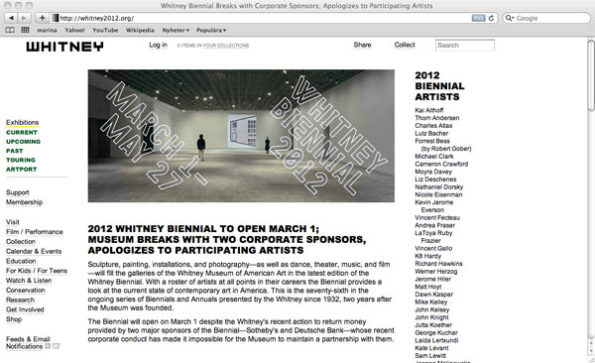Search
To search for an exact match, type the word or phrase you want in quotation marks.
A*DESK has been offering since 2002 contents about criticism and contemporary art. A*DESK has become consolidated thanks to all those who have believed in the project, all those who have followed us, debating, participating and collaborating. Many people have collaborated with A*DESK, and continue to do so. Their efforts, knowledge and belief in the project are what make it grow internationally. At A*DESK we have also generated work for over one hundred professionals in culture, from small collaborations with reviews and classes, to more prolonged and intense collaborations.
At A*DESK we believe in the need for free and universal access to culture and knowledge. We want to carry on being independent, remaining open to more ideas and opinions. If you believe in A*DESK, we need your backing to be able to continue. You can now participate in the project by supporting it. You can choose how much you want to contribute to the project.
You can decide how much you want to bring to the project.

The American museum celebrates its seventy-sixth edition of the Biennial since 1932, (it was initially annual) with its eyes focused on artists that redefine or revise their practice by linking it to the narratives of other artists, cultures and technologies: an intellectual struggle that is not always happily resolved. But one thing’s for sure, in this edition there are fewer artists than usual, only fifty-one and not all are American.
On Monday 27 February many breakfasted with this page, a cute fake that announced to the world a better biennial, as it renounced the sponsorship of two of the demons that profit so much from this crisis, Sotheby’s and Deutsche Bank, jettisoning ballast in the form of unfair dismissals and fraudulent mortgages. Three days later, right in the middle of the opening, various groups of the still active movement “Occupy Wall Street” appeared at the doors of the museum to protest alongside the workers of Sotheby’s and others victims of this biennial. While the curators delightedly received the activists, the press girls and protocol cast hasty glances in search of any VIPs still to arrive. All designed to enliven the imminent week of art fairs in New York and the incipient spring that has helped to warm up the political vibes of this electoral year.
Andrea Fraser, participates in this Biennial with an essay about the relations between the market and art, this contradictory situation, where as she says certain critical practices are promoted while at the same time are absorbed by a machinery nourished by the very corrupt and exploitative forces of our societies. Fraser identifies the discourses of art, (history, criticism, curatorship and “artists statements”) as the principal tools for hiding the social conditions of art, and as such as a cynical exercise, where equally “the dissociation of power and domination from material conditions of existence that has become endemic to our national political discourse and has contributed to the marginalization of labor and class-based struggles.” Bear in mind that while the existence of classes is denied in the United States, there is a return to a divide between rich and poor, similar to that of the beginning of the century. (No doubt not just in the USA). However Fraser also stresses what Pierre Bourdieu already detected, that any discourse of art that is reduced solely to social conditions, or that doesn’t take into consideration the negation of them, as the “genuine logic of the artistic phenomenon”, fails to understand what art is about. In line with this argument all that multitude of proposals of social practices, production of relations, emancipation of the spectator, intervention in the urban space and incessant talk of the social world, particularly in its “economic and affective” aspect, in order precisely to not talk about them, performs their negation. If a biennial reflects the pulse of art today, Fraser’s essay is a true diagnosis: the contradiction of the world of art is in the discourse of art, not in what we do but in what we say about what we are doing. Don’t miss reading it.
In “1% C’est Moi”, another essay available in the same link, published by Texte zur Kunst and which opens with a graph about economic inequality in the United States, was published anonymously in Artforum in the summer of 2011, as part of a project by Jacob Fabricius. In it Fraser enumerates the list of collectors and patrons of global art, their political leanings and their artistic investments. In it we find the reasoning behind how times of inequality provide booms in art. And that it is the fortunes that trade in art that also substitute public funds in the generation and promotion of biennials, fairs, study programmes, publications, residencies, prizes, et al. There is no art world without the support of those whose very activities jeopardise the world in which we live. Paradoxically in the United States they continue to look at the European model of cultural subvention as something that could reverse this vicious circle, while at the same time in Europe they are disarticulating these models in favour of the golden American dream. In the spring of 2010 Fraser began this investigation, for the summer edition of Artforum dedicated to museums, in which she traced the relationships between the patrons of MoMA and the crisis of the subprime. The article wasn´t published and her project to convert the investigation into an easily accessible website, from where to follow the ins and outs of art-money, has still not been realised.
There is a copy of the catalogue where one can read Fraser’s text, it occupies a white pedestal on the left of the entrance to the first floor, from there on, with an air of enchantment, of almost unreal fantasy, an exhibition brimming with references, quotations and encounters, with the intention of making us think about how an artist develops research. The curators Elisabeth Sussman (curator of photography at the Whitney) and Jay Sanders (independent) talk of a biennial open to all disciplines, however strange it might seem, it still surprises some people to have a space dedicated to performance.
In general we find artists who assume other skins, such as the Polish Joanna Malinowska, who combines her Duchampian “bottle rack” made with false and outsized bones with a video in which she re-enacts the “America likes me and I like America” by Beuys, beside a painting by Leonard Peltier, a Native-American artist and hero comparable to Mandela, having been unjustly imprisoned since 1976. By all means, an interesting selection where we can trace a reflection about nature in the American context and glimpse the separation that Anglo-Saxon culture has imposed, contrasted with other cultural references that suggest another form of harmony, combining the most avant-garde with the traditional of primitive sculpture. Right. Werner Herzog has in his room a multi-projection with the prints of Hercules Segers, a Dutch artist of the 17thC who transported landscape to the limits of expressionism. Close by there is another room with the selection that Robert Gober has made of the paintings of Forrest Bess, an abstract painter, contemporary of Rothko and Pollock, but who passed by unnoticed and who hides an interesting story as he self-applied surgery to open a hole just underneath his penis, with the idea that the retention of semen would help him, as it had helped the poet Yeats in his day, with his creativity. According to him becoming a pseudo-hermaphrodite would connect him transcendentally, renovating his vitality, by coming close to the feminine orgasm. His project however was never concluded and he was never able to implant the second penis that would have been able to transport him to another dimension. Bess, who ended his days in a nursing home, always wanted to exhibit the photographs of his operations beside his paintings, and here we finally see them together. Later on there is a video by Michael Robinson, in which he mixes the film of Cleopatra with Elisabeth Taylor with Egyptomania by Michael Jackson – I suppose somebody had to do it – the result is a psychedelic and hypnotic phantasmagoria.
On the second floor what stands out is the work by Sam Lewitt, which uses Ferrofluid, those ferromagnetic particles that are magnetically attracted by an organic solvent or water, forming sculptures that vary in accord with the nature of the metallic and magnetic support. In another room, some tapestries about the myth of Ariadne, by Elaine Reichek stand out, one traces a labyrinth with the inscription “There’s no need to build a labyrinth when the entire universe is one”, no doubt a reminder that one shouldn’t try to complicate life.
On the third floor there is the proposal by the artist Dawn Kasper, who has moved her studio-room to the museum, perhaps in part to avoid paying rent during the months of the exhibition, and as a way of getting something out of the Biennial (the artists are not paid) or maybe she is a secret admirer of Albert Porta/Zush/Evru dedicating herself to redoing his work. What also stand out are the paintings by Jutta Koether, who brings the four seasons by Poussin up to date, by incorporating the “fashion weeks” and other seasons of our time. And also the primitive-expressionist portraits by the French artist, Nicole Eisenman.
On the fourth floor, there is a large space dedicated to performances by Sarah Michelson and Michael Clark, the latter known for his collaborations in his native England, with artists such as Leigh Bowery, Sarah Lucas and The Fall. Both have set up residence for the months of the Biennial. The live art section culminates with a mannequin, that moves a doll like a ventriloquist, and with a touch of the sinister, maintains a dialogue about evil, a collaborative piece by Gisèle Vienne and Dennis Cooper. Finally there is the reproduction of a Latin transsexuals club from Los Angeles, a work by Wu Tsang, where videos of their performances are presented in a room crammed with furniture, costumes and people, who, rumour has it, are paid to stay there, enduring the ambient heat.
In short, a biennial full of phantasms, real ones if we think about the quantity of aforementioned dead, who for sure must affect us in the perverted ambiance of our contemporaneity in crisis. In favour of the exploitation of fantasy as the place where everything is possible, where the human collage, representing the permeability of the public and the private, transforms into the psychedelic energy that covers up the real social conditions of this world called art. Or, it will probably be my discourse that covers everything, as maybe like Jed Martin “I don’t even know if I am going to continue in art”.

Xavier Acarín is fascinated with experience as the driving force of contemporary culture. He has worked in art centres and cultural organizations both in Barcelona and New York, focussing in particular on performance and installation.
"A desk is a dangerous place from which to watch the world" (John Le Carré)